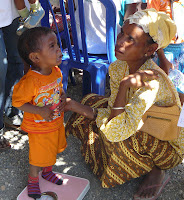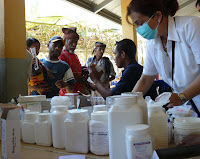Integrated community health services in Timor-Leste
After a two hour walk across several hills and through valleys in a mountainous part of Timor-Leste, have Paula and her four-year-old daughter Maria arrived at a simulation exercise of the integrated community health service. Driven by guilt she embarked on her tiresome journey with febrile Maria.
As I watch Paula line up amongst the many others jostling to register 
It begins with a registration booth. Many here proudly tell the assistants their names and where they have come from but the old swiftly fumble when asked their age. They are simple cannot remember. Shortly after they are given a slip of paper with their names written in bold, they are whisked away to the next booth. A couple of weighing scales are placed on the dusty ground and each individual is asked to stand on the weighing scales so that the health volunteers can take note of their weight and proceed to fill the next box on this slip of paper. Children too have come with their parents but many refuse to stand on these weighing scales, terrified of this strange object. This slows the pace as the health officials struggle to find a solution and fi
Booth number three dishes out information on reproductive health and family planning, evidently thin on patronage but nonetheless those manning the booth are gradually soliciting interest. A husband and wife, with their three children ranging from eight months to four years, are being coerced into better family planning. The young mother is shy and giggles occasionally but the father seemed noticeably perturbed, not by what the ladies at this booth are saying but the restlessness of the infant in his arms. After a sojourn of less than ten minutes they make their way to the next booth.
It is here where a little more enthusiasm ignites the children. They are each given a bar of soap to wash their hands and dirty little fingers. It’s the sanitation booth where parents and children are sensitized to the importance of basic hygiene. “You’ve got such a pretty little face but look at that black dirt beneath your finger nails,” exclaims the health worker who then embarks on cutting the child’s fingernails. Embarrassed by the comments, the child nestles her face into her mother’s armpits. She quickly perks up again when she’s given a tiny bag containing a small face towel and a bar of soap to take home.
There seems to be a longer wait at booth five, several rows of young and old men and women, already seated in line, waiting their turn to consult with the several doctors available. Waiting patiently is Paula and Maria. “I just hope the doctors can tell me what is causing Maria to be this sick. I want some answers. Maria has been unwell now with a high fever for the last four days and when it gets too much, she screams and I feel so helpless. I cradle her in my arms and kneel in front of our altar at home,” says the mother of three.
The simulation exercise is gaining momentum. “I’m pleased to see so many people here today. This is a good sign that SISCa is working,” comments the Minister of Health for Timor- Leste, Dr Nelson Martin. But could this be because the minister himself has come from the capital, Dili and the district chief and village heads have mobilized the community to welcome the guest and his entourage? “I’m convinced at least some of these people have come for their benefit and not because I’m here. That is my hope after all the aim of SISCa is about community participation for equitable distribution of health care. But I also believe only through greater advocacy will this service work better ensuring health care for all is possible” stressed Dr Martins who is observing the last of the simulation exercises to take place today in this sub-district located in the west of the country bordering Indonesia.
Meanwhile, Maria is pricked on her finger gently by the attending nurse so that a rapid test on her blood can be done to check against Malaria. It clearly does not hurt her but instead she is intrigued by the process. The prognosis is negative for Malaria. It’s a viral infection and because she has not had it treated till now, the infection led to the high fever. Paula listens intently to the doctor relieved so hear some answers. She takes note of what she should do with the medication she will receive from the pharmacists at the next booth and also how she can take simple steps at home to ensure this does not happen again to Maria or other members of her family.
“It will be awhile before we reach home now but I’m glad we came. Look even Maria is feeling better already it seems,” quips Paula as she places a bottle of water and some bananas in her a woven basket and begins her journey home.
What is SISCa?
Servisu Integradu da Saúde Communitária (SISCa) which translates from Portuguese to Integrated Community Health Services stands on the principle of “From, With and To the Community”, which signifies that it is the community who would help conduct the activity, mobilize people; men and women, children, youth, the elderly; together with all health workers to work side by side to give assistance, protect and improve the state of community health in the country.
Communities need to be part of this strong commitment to the importance of health. Hence, community leaders such as sub-district council members and chiefs, hamlet chiefs, youth organizations, women’s’ networks and other community leaders take the lead.
SISCa provides assistance in the areas of health promotion, prevention of diseases, treatment for sickness and rehabilitation as well as health interventions such as combating against infectious diseases, family planning, nutrition, maternal and child health and environmental health. It covers all sub-districts in all 13 districts in the country. Its activities are carried out once a month to ensure sustainability. The activities at SISCa last for a minimum of four hours, to ensure that communities will have time and the opportunity to participate. Community members play a role in deciding the schedule of SISCa activities.
- Citizen News Service (CNS)
Published in:
Citizen News Service (CNS), India/Thialand
Modern Ghana News, Accra, Ghana
Elites TV News, USA
Asian Tribune News
Media For Freedom, Nepal
Bihar and Jharkhand News Service (BJNS)
Timor News Network
World News Network (USA)
Banderas News, Mexico
The Colombo Times, Colombo, Sri Lanka
News Now, UK
World News Report
Tweetmeme.com
Allvioces.com
Twitter.com
Timor News
Inbox Robot News
World News Report







